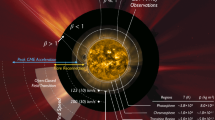Abstract
The gas flux from a volatile icy-dust mixture is computed using a comet nucleus thermal model in order to study the evolution of CO outgassing during several apparitions from long-period Comet Hale-Bopp and short-period Comet Wirtanen. The comet model assumes a spherical, porous body containing a dust component, one major ice component (H2O), and one minor ice component of higher volatility (CO). The initial chemical composition is assumed to be homogeneous. The following processes are taken into account: heat and gas diffusion inside the rotating nucleus; release of outward diffusing gas from the comet nucleus; chemical differentiation by sublimation of volatile ices in the surface layers and recondensation of gas in deeper, cooler layers. A 2-D time dependent solution is obtained through the dependence of the boundary conditions on the local solar illumination as the nucleus rotates. The model for Comet Hale-Bopp was compared with observational measurements (Biver et al., 1999). The best agreement was obtained for a model with amorphous water ice and CO, assuming that a part of the latter is trapped by the water ice, another part is condensed as an independent ice phase. The model confirms that sublimation of CO ice at large heliocentric distance produces a gradual increase in the comet's activity as it approaches the Sun. Crystallization of amorphous water ice begins at 7 AU from the Sun, but no outbursts were found. Seasonal effects and thermal inertia of the nucleus material lead to larger CO outgassing rates as the comet recedes from the Sun. In the second part of this work the model was run with the orbital parameters of Comet Wirtanen. Unlike Comet Hale-Bopp, the predicted CO outgassing from Comet Wirtanen is almost constant throughout its orbit. Such behavior can be explained by a thermally evolved and chemically differentiated comet nucleus.
Similar content being viewed by others
References
Bailey, M., Emelyanenko, V.V., Hahn, G., Harris, N.W., Hughes, K.A., Muinonen, K., and Scotti, J.V.: 1996,’ Orbit evolution of comet O1 Hale-Bopp’, Mon. Notes Roy. Astron. Soc. 281, 916–924.
Bar-Nun, A., Herman, G. and Laufer, D.: 1985,’ Trapping and release of gases by water iceand implications for icy bodies’, Icarus 63, 317–332.
Biver, N., Bockelée-Morvan, D., Colom, P., Crovisier, J., Davies, J., Dent, W., Despois, D., Gérard, E., Rauer, H., Moreno, R., Paubert, G., Lis, D., Mehringer, D., Benford, D., Gardner, M. and Philips, T.: 1999,’ Long term evolution of the outgassing of comet Hale-Bopp from radio observations’, Earth, Moon, and planets, in press.
Bockelée-Morvan, D. and Rickman, H.: 1999,’ C/1995 O1 (Hale-Bopp): Gas production curvesand their interpretation’, Earth, Moon, and Planets, in press.
Crifo, J.-F., and Rodionov, A.V.: 1997,'The dependence of the circumnuclear coma structure on the characteristics of the nucleus. I comparison between a homogeneous and an inhomogeneous spherical inucleus, with application to P/Wirtanen’, Icarus 127, 319–353.
Ehrenfreund, P.: 1999,’ An ISO view on interstellar and cometary ice chemistry’, Space Sci.Rev., this volume.
Enzian, A., Cabot, H. and Klinger, J.: 1997,’ A 2 1/2 D thermodynamic model ofcometary nuclei: I Application to the activity of comet 29P/Schwassmann-Wachmann 1’, Astron. Astrophys. 319, 995–1006.
Enzian, A., Cabot, H. and Klinger, J.: 1998,’ Simulation of the waterand carbon monoxide production rates of comet Hale-Bopp using a quasi 3D nucleus model’, Planet. Space Sci. 46,851–858.
Enzian, A., Klinger, J., Schwehm, G. and Weissman, P.:’ Temperature and gasproduction distributions on the surface of a spherical model comet nucleus in the orbit of 46P/Wirtanen’, Icarus 138, 74–84.
Di Folco, E., and Bockelée-Morvan, D.: 1997, Thesis, Observatoirede Paris Meudon, Université Paris VII.
Fulle, M., Cremonese, G. and Bohm, C.: 1998,’ The pre-perihelion dust environment of C/1995 O1 Hale-Bopp from 14 to 4 AU’, Astron. J. 116, 1470–1477.
Huebner, W., and Benkhoff, J.: 1999,’ From coma abundances to nucleus composition’, Space Sci.Rev., this volume.
Huebner, W., Benkhoff, J., Capria, M., Coradini, A., Sanctis, M.D., Enzian, A., Orosei, R.and Prialnik, D.: 1998, Results from the Comet Nucleus Model Team at the International Space Science Institute, Bern, COSPAR proceedings, in press.
Jenniskens, P. and Blake, D.F.: 1994,’ Structuraltransitions in amorphous water ice and astrophysical implications’, Science 265, 753–756.
K¨uhrt, E.:1999,’ H2O activity of comet Hale-Bopp’, Space Sci. Rev., this volume.
Lamy, P.L.: 1996,'Comet 46P/Wirtanen’, IAU Circ. No 6478.
Meech, K.J., Bauer, J. and Hainaut, O.: 1997,'Rotation of comet Wirtanen’, Astron. Astrophys. 326, 1268–1276.
Roettger, E.E., Feldman, P.D. and A'Hearn, M.F.:’ Comparison of water production rates from UV spectroscopy and visual magnitudes for some recent comets’, Icarus 86, 100–114.
Schmitt, B. and Klinger, J.: 1987,’ Differenttrapping mechanisms of gases by water ice and their relevance for comet nuclei’, In Symposium on the Diversity and Similarity of Comets, pages 613–619, Noordwijk, The Netherlands, ESA SP-278, 1987.
Sekanina, Z.,and Boehnhardt, H.: 1999,’ Dust Morphology of Comet Hale-Bopp (C/1995 O1)’, Earth, Moon, and Planets, in press, 1999.
Weissman, P.R. and Kieffer, H.H.: 1984,’ An improved thermal model forcometary nuclei’, Journal of Geophysical Research 89, C358–C364.
Weaver, H. and Lamy, P.:1999,’ Estimating the Size of Hale-Bopp's Nucleus’ Earth, Moon, and Planets, in press.
Rights and permissions
About this article
Cite this article
Enzian, A. On the Prediction of CO Outgassing from Comets Hale-Bopp and Wirtanen. Space Science Reviews 90, 131–139 (1999). https://doi.org/10.1023/A:1005293913762
Issue Date:
DOI: https://doi.org/10.1023/A:1005293913762




